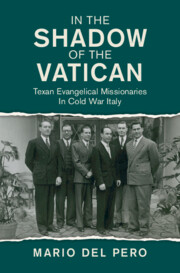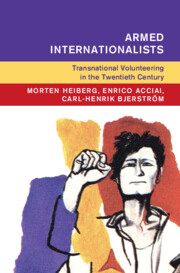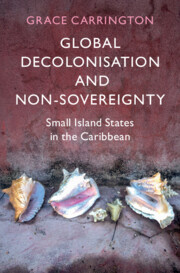Refine search
Actions for selected content:
624 results
4 - De-democratization and Discontent: Backing away from Economic Liberalism, 1954–1955
-
- Book:
- The Rise and Fall of Turkey's Democrat Party
- Published online:
- 23 October 2025
- Print publication:
- 06 November 2025, pp 144-179
-
- Chapter
- Export citation
Introduction
-
- Book:
- The Rise and Fall of Turkey's Democrat Party
- Published online:
- 23 October 2025
- Print publication:
- 06 November 2025, pp 1-24
-
- Chapter
- Export citation
Introduction
-
- Book:
- In the Shadow of the Vatican
- Published online:
- 23 October 2025
- Print publication:
- 06 November 2025, pp 1-13
-
- Chapter
- Export citation
7 - India and the World
- from Part IV - India and the World
-
- Book:
- Democracy and Inequality in India
- Published online:
- 11 October 2025
- Print publication:
- 30 October 2025, pp 267-295
-
- Chapter
- Export citation

The Making of Revolutionary Feminism in El Salvador
-
- Expected online publication date:
- September 2025
- Print publication:
- 18 September 2025

The Rise and Fall of Turkey's Democrat Party
- The Cold War and Illiberalism, 1945–60
-
- Published online:
- 23 October 2025
- Print publication:
- 06 November 2025

In the Shadow of the Vatican
- Texan Evangelical Missionaries in Cold War Italy
-
- Published online:
- 23 October 2025
- Print publication:
- 06 November 2025
The Firm, the Bank, and the Family: Military Intelligence and the Wallenbergs in Sweden’s Cold War
-
- Journal:
- Enterprise & Society , First View
- Published online by Cambridge University Press:
- 23 October 2025, pp. 1-30
-
- Article
-
- You have access
- Open access
- HTML
- Export citation
2 - Overpopulation Discourse and the Post-1945 Order
-
- Book:
- Population Control as a Human Right
- Published online:
- 09 October 2025
- Print publication:
- 23 October 2025, pp 17-31
-
- Chapter
- Export citation
4 - Breakthrough of a Human Rights Framework in the 1960s
-
- Book:
- Population Control as a Human Right
- Published online:
- 09 October 2025
- Print publication:
- 23 October 2025, pp 55-81
-
- Chapter
- Export citation
Circulating Violence: Guerre contre-révolutionnaire as the Intellectual Foundation of Modern Torture
-
- Journal:
- Comparative Studies in Society and History , First View
- Published online by Cambridge University Press:
- 17 October 2025, pp. 1-27
-
- Article
-
- You have access
- Open access
- HTML
- Export citation
7 - The Premiere of Haydn’s Orfeo in Florence (1951)
-
-
- Book:
- Haydn Studies 2
- Published online:
- 18 October 2025
- Print publication:
- 16 October 2025, pp 155-181
-
- Chapter
- Export citation
Revolutionary Self-Determination? Third-Worldism, Anti-Colonialism and Ethnonationalism in Western Europe (1955-1980)
-
- Journal:
- Nationalities Papers , FirstView
- Published online by Cambridge University Press:
- 14 October 2025, pp. 1-16
-
- Article
-
- You have access
- Open access
- HTML
- Export citation
1 - Combatants without Borders
-
- Book:
- Armed Internationalists
- Published online:
- 19 September 2025
- Print publication:
- 09 October 2025, pp 1-18
-
- Chapter
- Export citation

Armed Internationalists
- Transnational Volunteering in the Twentieth Century
-
- Published online:
- 19 September 2025
- Print publication:
- 09 October 2025
The Tito-Stalin Split and Yugoslav Diaspora in Australia and New Zealand
-
- Journal:
- Nationalities Papers , FirstView
- Published online by Cambridge University Press:
- 19 September 2025, pp. 1-16
-
- Article
-
- You have access
- Open access
- HTML
- Export citation
Introduction
-
- Book:
- The Making of Revolutionary Feminism in El Salvador
- Print publication:
- 18 September 2025, pp 1-51
-
- Chapter
- Export citation

Global Decolonisation and Non-Sovereignty
- Small Island States in the Caribbean
-
- Published online:
- 16 September 2025
- Print publication:
- 31 July 2025
Lawyers’ Activism, International Law, and Human Rights in the Cold War Era: The Emergence of Radical Legal Internationalism
-
- Journal:
- Law and History Review , First View
- Published online by Cambridge University Press:
- 16 September 2025, pp. 1-25
-
- Article
-
- You have access
- Open access
- HTML
- Export citation
Past Landscapes of Bias: Refuse at Abandoned Cold War Soviet Nuclear Bases in Poland
-
- Journal:
- European Journal of Archaeology , First View
- Published online by Cambridge University Press:
- 12 September 2025, pp. 1-21
-
- Article
-
- You have access
- Open access
- HTML
- Export citation
